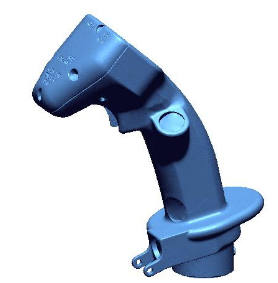 It’s part amazing, part scary, the ability for everyday people like you and me to turn physical objects into 3D computer models. Anyone with a 3D scanner, 3D printer, and a little bit of skill is able to pretty much make copies of thousands upon thousands of everyday objects. It sounds like something from Star Trek, but this is our reality, and things are just getting started. Although the laundry list of possible legal implications seems to be overwhelming, this very technology may be a major driver of innovation, affordability, and customization moving forward.
It’s part amazing, part scary, the ability for everyday people like you and me to turn physical objects into 3D computer models. Anyone with a 3D scanner, 3D printer, and a little bit of skill is able to pretty much make copies of thousands upon thousands of everyday objects. It sounds like something from Star Trek, but this is our reality, and things are just getting started. Although the laundry list of possible legal implications seems to be overwhelming, this very technology may be a major driver of innovation, affordability, and customization moving forward.
One company called NeoMetrix Technologies is showing us all just how powerful this technology can be. With 20 years of reverse engineering experience, they have recently adopted 3D scanning as their main tool of operation. From can openers to gun parts, this has allowed the company to improve upon several designs for products and components which are already on the market. Reverse engineering projects which may have taken weeks or months before, can take just a few hours thanks to present day technologies. Below are a few examples of how Florida-based NeoMetrix has utilized 3D scanning to reverse engineer various everyday objects. These objects can then be sent to a 3D printer and turned into actual physical objects.
The Can Opener
What happens when you notice a flaw in a product you use almost every day? Usually you go out and buy a different one. When Neometrix came upon a design flaw in a can opener, they  decided to reverse engineer it. Since there were no drawings of the original parts, and hand measurements of the oddly shaped components that make up the can opener would be nearly impossible, they decided to laser scan each component with a Konica Minolta Range 7 scanner. Once scanned, the team used Rapidform XOR (now called Geomagic Design X) to merge each scan together. The merged scans were then transferred to Solidworks where they were fully assembled on screen. The ability to capture the complex geometries of the can opener in short times unimaginable with traditional modeling techniques certainly was a plus. This gave the company the ability to change the design, or 3D print individual parts to match them up to the originals.
decided to reverse engineer it. Since there were no drawings of the original parts, and hand measurements of the oddly shaped components that make up the can opener would be nearly impossible, they decided to laser scan each component with a Konica Minolta Range 7 scanner. Once scanned, the team used Rapidform XOR (now called Geomagic Design X) to merge each scan together. The merged scans were then transferred to Solidworks where they were fully assembled on screen. The ability to capture the complex geometries of the can opener in short times unimaginable with traditional modeling techniques certainly was a plus. This gave the company the ability to change the design, or 3D print individual parts to match them up to the originals.
The Custom Made Guitar
 What happens if you want to make a duplicate, or at least a 3D model of a custom made guitar? Obviously there are no design files or drawings available, likely the product of hours of shaping, grinding, and sanding. That doesn’t mean it’s impossible to make a CAD model for mass production though.
What happens if you want to make a duplicate, or at least a 3D model of a custom made guitar? Obviously there are no design files or drawings available, likely the product of hours of shaping, grinding, and sanding. That doesn’t mean it’s impossible to make a CAD model for mass production though.
NeoMetrix once again relied on a Konica Minolta Range 7 scanner with accuracies set at 0.0015″. They scanned the guitar, producing a polygon mesh using Rapidform XOR. From there they used the mesh to create a solid 3D model which was as close to the actual guitar as possible. The model can then be modified, and various rapid surfacing techniques can be applied. The guitar was ready for mass production if they wanted to begin selling these in quantity.
The Flight Grip
Most of us have never trained to be a fighter pilot, but those who have done so understand the importance of flight simulation to the training process. The flight grip of a  simulator must be nearly exact, so that when a pilot does take to the skies, there are no surprises. Traditionally, in order to create a flight grip for a simulation, one would be required to purchase the actual components used within the aircraft, which can be extremely expensive. Otherwise they would have to opt to reverse engineer the grip using hand tools and calipers, which is time consuming and less accurate.
simulator must be nearly exact, so that when a pilot does take to the skies, there are no surprises. Traditionally, in order to create a flight grip for a simulation, one would be required to purchase the actual components used within the aircraft, which can be extremely expensive. Otherwise they would have to opt to reverse engineer the grip using hand tools and calipers, which is time consuming and less accurate.
In comes NeoMetrix, once again equipped with a Konica Minolta Range 7 scanner. The scan data is merged and aligned in Rapidform XOR, and a mesh is used to create a solid model. This model can then be used by manufacturers for rapid prototyping of the part via 3D printing, or to run finite element or computational fluid dynamics analysis on.
As scanners and especially 3D printers continue to develop, there will undoubtedly be a time when just about anyone can 3D scan and print just about any object within hours. When this happens, economies will need to adapt, and markets will need to adjust, as an entirely new model of manufacturing will be present.
Let’s hear your thoughts on NeoMetrix’s case studies above. Discuss in the Reverse Engineering forum thread on 3DPB.com.
Subscribe to Our Email Newsletter
Stay up-to-date on all the latest news from the 3D printing industry and receive information and offers from third party vendors.
You May Also Like
3D Printing Unpeeled: New Arkema Material for HP, Saddle and Macro MEMS
A new Arkema material for MJF is said to reduce costs per part by up to 25% and have an 85% reusability ratio. HP 3D HR PA 12 S has been...
3D Printing News Briefs, January 20, 2024: FDM, LPBF, Underwater 3D Printer, Racing, & More
We’re starting off with a process certification in today’s 3D Printing News Briefs, and then moving on to research about solute trapping, laser powder bed fusion, and then moving on...
3D Printing Webinar and Event Roundup: December 3, 2023
We’ve got plenty of events and webinars coming up for you this week! Quickparts is having a Manufacturing Roadshow, America Makes is holding a Member Town Hall, Stratafest makes two...
Formnext 2023 Day Three: Slam Dunk
I’m high—high on trade show. I’ve met numerous new faces and reconnected with old friends, creating an absolutely wonderful atmosphere. The excitement is palpable over several emerging developments. The high...
































